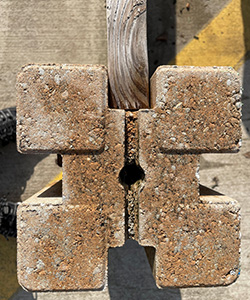Wendy’s Wanderings

Fresh Takes on Raised-bed Gardening Materials
July 8, 2025
Recently, I had the pleasure of visiting UF/IFAS Extension Columbia County’s demonstration garden for a cut-flower field day. Extension agents and Master Gardener Volunteers were invited to evaluate a beautiful trial of sunflowers, zinnias, snapdragons and marigolds. Erin Harlow and her team of MGVs did a fantastic job of hosting the event and collecting valuable feedback that will be shared with the Association of Specialty Cut Flower Growers (ASCFG). The blooms were stunning and the whole event left many of us inspired to grow more cut flowers in our own gardens.

As I admired the garden layout, I noticed something particularly clever about the construction of the raised beds. Erin and her team had used concrete garden-bed corner blocks—small masonry units that allow you to easily slide 2×6 or 2×4 boards into notches to create a quick, sturdy raised bed. No power tools, screws or hardware required. These blocks are stackable too, which means you can build taller beds for crops that need deeper soil, like carrots or potatoes. Although these blocks have been around for a while, this was my first time seeing them in use—and I was impressed. They make raised-bed construction accessible for nearly any gardener.
Later that same week, I was visiting a summer gardening camp where the campers were planting in a completely different style of raised bed—made of fabric! I’ve seen individual grow bags before, but this was a full raised-bed unit made from breathable black fabric. It spanned roughly 6 feet by 3 feet and was divided into eight compartments, each filled with thriving herbs and vegetables. This lightweight, tear-resistant material is ideal for temporary or seasonal gardening, but many gardeners report that these fabric beds last for several years. They are easy to store when not in use and offer excellent drainage and airflow to plant roots.
Another option growing in popularity is the coated-metal raised bed. These sleek, modern-looking beds are made of weather-resistant metal and often stand much taller than traditional wooden beds—some up to 2 feet high. This added height makes gardening more ergonomic by reducing the amount of bending and kneeling required. While taller beds do require more soil to fill, many gardeners find the increased accessibility and durability well worth the investment. Most are rated for up to 20 years of use.
No matter which material you choose, raised bed gardening offers many benefits. If your native soil is sandy or compacted, raised beds allow you to control the growing media from the start. They also tend to drain better, heat up earlier in the season, and make watering and fertilizing more efficient. Raised beds are easy to fit into a residential landscape, and because they elevate the plants, harvesting and weeding become simpler tasks.
If you’ve used raised beds before, consider trying one of these new materials to reinvigorate your gardening experience. For more information and construction tips, read Building Raised Beds on UF/IFAS Gardening Solutions.
